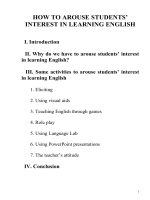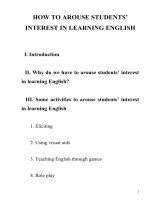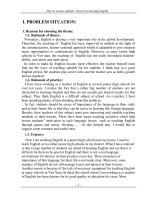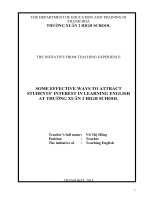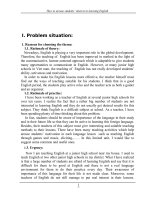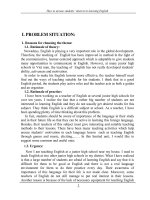skkn cấp tỉnh some methods to arouse students interest in learning english idioms
Bạn đang xem bản rút gọn của tài liệu. Xem và tải ngay bản đầy đủ của tài liệu tại đây (1.44 MB, 26 trang )
<span class="text_page_counter">Trang 1</span><div class="page_container" data-page="1">
THANH HOA EDUCATION AND TRAINING DEPARTMENT
<b>THACH THANH I HIGH SCHOOL</b>
EXPERIENTIAL INITIATIVE
<b>SOME METHODS TO AROUSE STUDENTS’ INTEREST INLEARNING ENGLISH IDIOMS </b>
<b>Author: Vũ Thị XuânOccupation: Teacher</b>
<b>Experiential initiative on: English</b>
<small>THANH HOA, YEAR 2024</small>
</div><span class="text_page_counter">Trang 2</span><div class="page_container" data-page="2"><b> INDEX</b>
<b> 1<sup>1. Introduction</sup></b><sub>1.1. The reason for choosing the topic</sub>
1.2. The purpose of research1.3. Study subjects
<b>1.4. Research Methodology </b>
2.3.1.1. Idioms with colors
2.3.1.2. Idioms with parts of body2.3.1.3. Idioms with kinds of animals2.3.1.4. Idioms with verb phrases
2.3.1.5. Idioms with adjective and adverb phrases
<b>2.3.2. Teaching idioms by using pictures2.3.3. Teaching idioms through dialogues2.3.4. Teaching idioms by using flashcards 2.3.5. Teaching idioms by making questions2.3.6. Some suggested exercises for idioms2.4. The effect of initiative experience </b>
<b>33444444567781114151619</b>
</div><span class="text_page_counter">Trang 3</span><div class="page_container" data-page="3"><b>1. Introduction</b>
<b>1.1. The reason for choosing the topic</b>
Today, English has become an international language. It is spoken as asecond language and an official language in many countries, and millions ofpeople speak English as a foreign language. Besides, English is considered themedium of communication in many fields such as science, technology, aviation,internet, commerce, and so on. Therefore learning and teaching English aregetting more and more important to non-native nations of English.
However, all languages have phrases or sentences that cannot beunderstood literally. Even if we know the meaning of all the words in a phraseand understand all the grammar of the phrase completely, the meaning of thephrases may be still confused. A phrase or sentence of this type is said to beidiomatic. We have probably spent a long time learning new words. Words,however, do not just come in expressions. Idioms are among of the mostcommon of these expressions. There are thousands of them in English andidioms are part of vocabulary in students’ course books and no teachers canneglect teaching them since they constitute an important part. That’s why idiomteaching and learning are often considered as a hard task.
Having identified the problem, I have tried to search for solutions to helpstudents learn idioms more efficiently. Thus, in this writing I would like to share
<b>“Some methods to arouse students’ interest in learning English idioms”</b>
with the hope that my colleagues can also considered my teaching strategies asuseful suggestions to help their students become more interested and confidentin learning English.
<b>1.2. The purpose of research</b>
Helping students at Thach Thanh I High School understand English betterthrough learning idioms.
<b>1.3. Study subjects</b>
Research subjects are students in grades 11 and 12 of Thach Thanh I HighSchool, school year 2023-2024.
<b>1.4. Research Methodology</b>
- Finding out difficulties that students have in English classes.
<b>- Research methodology through the documents: Book of Applied Informatics,</b>
Internet, textbooks 11, 12, teacher books, exercise books and related documents.- Discussing with colleagues.
- Attending classes of co-workers
</div><span class="text_page_counter">Trang 4</span><div class="page_container" data-page="4">- Applying ideas in teaching
- Observing and drawing out experiences.
- Research Methodology of actual survey, gathering information and dataprocessing.
- Research methods from the actual teaching and learning of each student object.
<b>2. Contents of the initiative experience2.1. Rationale of the initiative experience</b>
<b> What are idioms? There are many definitions which refer to the term</b>
“idiom”. Being part of phraseology, idioms are defined as “a string of wordswhose meaning is different from the meaning conveyed by the individual words
<i>(Larson, 1984). In Longman dictionary of English idioms, idioms are refered to</i>
as “ a fix group of words with a special different meaning from the meaning of
<i>the separate words.” Moon (2006) defined “idioms as a fix sequence of words</i>
which has a meaning beyond that of the constituent parts.” Another definitioncontributed by Iujo (1986) is that “an idiom is a conventionalized expressionwhose meaning cannot be determined from the meaning of its parts. Idiomsdiffered from other figurative expression, such as similes and metaphors, inwhich they have conventionalized meanings.” Taking into consideration, theidiom definition as a group of words the meaning of which is different from themeaning of its constituents. Translation is not an easy task to perform. That’swhy teachers and scholars find this process difficult but we cannot omit teachingidioms because of its importance in the understanding of English.
Idioms are essential to successful communication whether in listening,speaking, reading or writing. The accurate and appropriate use of idioms is adistinctive mark of native- level command of the language and it is a reliablemeasure of the proficiency of foreigner learners. It is a fact that ignoring idiomswould cause a learner various problems. That is why foreign language learnersmust learn not only the grammatical structure and vocabulary of the targetlanguage but also the idioms to integrate into the culture of the target language. Idioms are clearly presented in academic settings, consequently, failure tocomprehend idioms could affect academic performance. A sound knowledge ofidioms is required in advanced English tests such as the National Exam or IeltsTest because learners’language proficiency might be assessed on the basis oftheir understanding of idiomatic expression. This means that the more idiomsone knows, the more native-like one’s English will sound. Additionally, bylearning idioms, one accordingly learn about the culture of the community thatspeak the language.
</div><span class="text_page_counter">Trang 5</span><div class="page_container" data-page="5">The use of Methods to teach idioms is not new. But how to apply thesemethods efficiently and to overcome difficulties in the teaching of idioms iswhat I want to share and present in this writing.
<b>2.2. Situation of the problem before applying the initiative experience2.2.1. For the teacher:</b>
Most teachers understand the importance of learning idioms, especially forhigh school students. But until now there remain many teachers who are fearfuland confused of the ways to teach idioms. They are not confident of when toteach, how much time they should spend on idioms and especially how topresent them clearly and comprehensibly.
<b>2.2.2. For the students:</b>
Many students also said that, English is so challenging to learn because thelanguage is full of idioms and slang. They are often at a loss when seeing orconversing with native speakers who never stop thinking about idioms becausethey have become a natural part of conversation skills.
These are the problems that urge me to find out the solutions to helpstudents get over the difficulties and hold interest in the foreign language in aflexible and easy way. To know exactly about the problem, I investigated 165students in four classes before applying the study by asking them the following
<i><b>question: Are you interested in learning English idioms?</b></i>
Here are the results:
<b>2.3.1.1. Idioms with colors</b>
<b>-With flying colors:</b> If you do something such as pass an exam with flying colors, you do it very successfully
</div><span class="text_page_counter">Trang 6</span><div class="page_container" data-page="6"><b>- Red-letter day: a special, happy, and important day that you will always</b>
<i><b>- In the red: spending more money than you can earn</b></i>
<i><b>- Caught red-handed: to catch someone in the act of doing something- Green thumb: to be skilled at gardening</b></i>
<i><b>- The red tape: official rules and processes that seem unnecessary and delay</b></i>
<i><b>- Once in a blue moon: very rarely</b></i>
<i><b>- Take the red eye: a late night flight that arrives early in the morning- Tickled pink: to be extremely pleased</b></i>
<i><b>- White lie: a small lie that is told to be polite or avoid hurting someone’s </b></i>
<b>2.3.1.2. Idioms with parts of body</b>
Teacher can give students a number of idioms which are related to thetopic parts of body then check their understanding by some relevant exercises.
<i><b>The heart</b></i>
<b>- Learn something off by hear: learn something completely</b>
<b>- You’re all heart!: when you tell someone sarcastically how kind they are. - Hand on heart: promise with sincerity</b>
<b>- Have the heart: be able to give someone bad news- A heart of gold: be a very kind person</b>
<i><b>- By heart: by memory</b></i>
<b>- Hand over: pass on something:</b>
<b>- Get out of hand: become impossible to manage</b>
<b>- Know something like the back of your hand: know something well - In hand: under control</b>
<b>- Give someone a hand: help someone</b>
<b>- Butter fingers: be clumsy and drop things</b>
<b>- Keep your fingers crossed: wish something for someone- Under your thumb: control someone</b>
<b>-Have st at one's fingertips: To have the information, knowledge, etc. That is</b>
needed in a particular situation and be able to find it easily and use it quickly
</div><span class="text_page_counter">Trang 7</span><div class="page_container" data-page="7"><i><b>Arms, feet and legs</b></i>
<b>- Cost an arm and a leg: cost a fortune = very expensive- Put your foot in it: say or do something you shouldn’t- Walk on eggshells: be careful about what you say or do</b>
<i><b>- To shake a leg: to be in a hurry</b></i>
<b>- To pull sb’s leg: to tell somebody something that is not true, as a joke.</b>
<i><b>The back</b></i>
<b>- Scratch someone's back: Help someone out with the assumption that they will</b>
return the favor in the future
<b>- Go behind someone’s back: do something secretly- Back someone up: support someone</b>
<b>- Tab someone in the back: betray someone</b>
<i><b>Other parts on the face</b></i>
<b>- Pay through the nose: To pay too much for something</b>
<i><b>- Not bat an eye: To not show any shock or surprise</b></i>
<b>- Led somebody by the nose: To control someone and make them do exactly </b>
what you want them to do
<i><b>- See eye to eye with sb: totally agree </b></i>
<b>- A big mouth: people who reveals secrets</b>
<i><b>- To have a sweet tooth: people who like eating sweet foods.- Head over heels in love: completely in love with another- A long face: an unhappy or disappointed expression.</b></i>
<i><b>- A pain in the neck: any kind of annoyance or a source of grief.</b></i>
<b>- Hit the nail on the head = Do or say something exactly right2.3.1.3. Idioms with kinds of animals</b>
<b>- Teacher's pets: a student in a class who the teacher likes and therefore treated </b>
better than the other students
<b>- Kill two birds with one stone: to succeed in achieving two things in a single</b>
<b>- Rain cats and dogs: </b>to rain very heavily
<b>- Don't count your chickens before they're hatched: said to emphasize that </b>
you cannot depend on something happening before it has happened
<b>- Take the mickey out of sb: make fun of sb</b>
</div><span class="text_page_counter">Trang 8</span><div class="page_container" data-page="8"><b>- When pigs fly: something will never happen</b>
<b>- A big fish in a small pond: </b>to have a lot of influence only over a small area
<b>- Like water off a duck’s back: </b>criticisms of or warnings to a particular person that have no effect on that person
<b>-Let the cat out of the bag: tell a secret.</b>
<i><b>- Have a bee in your bonnet: be obsessed by something.- A memory like an elephant: have an excellent memory.</b></i>
<b>- Have butterflies in your stomach: be very nervous about something.</b>
<i><b>- Take the bull by the horns: face a problem and take action.</b></i>
<i><b>- Like a fish out of water: feel very uncomfortable in a particular situation.- Make a mountain out of a molehill: make a big issue out of something small.</b></i>
<b>2.3.1.4. Idioms with verb phrases</b>
<b>- To get in hot water: be in trouble/ have difficulty- To hit the books: to study</b>
<b>- To hit the roof = to hit the ceiling: to suddenly become angry</b>
<b>- To burn the midnight oil: to stay up working, especially studying late at night- To take it amiss: to understand as wrong or insulting, or misunderstand</b>
<b>- To call it a day: stop working</b>
<b>- To make ends meet: </b>to have just enough money to pay for the things that you need
<b>- To drop sb a line/note: </b>To write someone a letter
<b>- To beat around the bush: to avoid talking about what is important.</b>
<b>- To miss the boat: </b>to lose an opportunity to do something by being slow to act.
<b>- To throw the baby out with the bathwater: </b>to lose valuable ideas or things in your attempt to get rid of what is not wanted
<b>2.3.1.5. Idioms with adjective and adverb phrases- At the drop of a hat: immediately, instantly</b>
<b>- High and low: here and there = far and wide: everywhere- On the spot: immediately</b>
<b>- On the top of the world = walking on the air = over the moon= like a dog with two tails: </b>to feel extremely excited or happy
<b>- Under the weather: </b>If someone is or feels under the weather, they feel ill
<b>- Home and dry = with flying colors: </b>to have successfully finished something.
<b>- Apples and oranges = chalk and cheese: </b>used to say that two things are completely different and it is not sensible to compare them:
<b>- Now and then = once in a while: sometimes, occasionally- A tall story: unbelievable</b>
<b>- High and dry: in a difficult situation, without help or money- On pins and needles: nervous</b>
</div><span class="text_page_counter">Trang 9</span><div class="page_container" data-page="9"><b>- Safe and sound: completely safe and without injury or damage:- As high as a kite: means to feel very happy and excited.</b>
<b>- Hot under the collar: embarrassed or angry about something.</b>
<b>- In the same boat: </b>to be in the same unpleasant situation as other people.
<b>2.3.2. Teaching idioms by using pictures</b>
Provide a picture to explain the context. This works best if we show animage that humorously illustrates the literal meaning of the idiom. It will makestudents laugh, but also help them understand or guess what a phrase means.Idioms are full of colorful imagery, perfect for a flashcard or photo. Show thepicture to our students and have them guess the meaning of the idiom.
From there, give examples of when they would use it and how the wordsand the actual meaning of the idiom are different.
<b>1. “Costs an arm and a leg”</b>
<i><b>Meaning: </b></i>This idiom is used when something is very expensive.
<b>2 . “Under the weather”</b>
</div><span class="text_page_counter">Trang 10</span><div class="page_container" data-page="10">
<i><b>Meaning: being sick</b></i>
<b>3. “Kill two birds with one stone”</b>
<i><b>Meaning : to succeed in achieving two things in a single action</b></i>
<b>4."Have your head in the clouds" </b>
<i><b>Meaning: to be out of touch with reality; to be daydreaming</b></i>
<b>5."Put your foot in your mouth"</b>
</div><span class="text_page_counter">Trang 11</span><div class="page_container" data-page="11">
<i><b>Meaning: Saying something that shouldn't be said </b></i>
<b>6 . "Sit on the fence"</b>
<i><b>Meaning: undecided, uncertain, neutral</b></i>
<b>7. “Hit the sack” </b>
<b> </b>
<i><b>Meaning: to go to bed</b></i>
<b>8. “To be broke”</b>
</div><span class="text_page_counter">Trang 12</span><div class="page_container" data-page="12">
<i><b>Meaning: to be out of money, to have no money</b></i>
<b>9. “Break the ice”</b>
<i><b>Meaning: to say something that start a conversation</b></i>
<b>10. “Let the cat out of the bag”</b>
<i><b>Meaning: to tell a secret.</b></i>
<b>2.3.3. Teaching idioms through dialogues</b>
It is important to learn and use idioms in context. Of course idioms are notalways easy to understand but reading them in short dialogues or stories can alsoprovide context that makes them more alive. After students understand thedialogues, teachers can give a quiz at the end of each reading to test their
</div><span class="text_page_counter">Trang 13</span><div class="page_container" data-page="13">understanding. This method is often applied to advanced-level classes. Here aresome examples.
1. TO PUT YOUR FOOT IN IT A
Well what happened?
B: We were talking about that man over there. A
What - that one? With the dreadful hair and those awful clothes? B: Exactly. I just said how odd I thought he looked.
A:
And?
B: He happens to be that woman's husband A
<i><b> Oh dear. You really put your foot in it, didn't you.</b></i>
2. OUT OF THE BLUE A
Where's Helen these days? I haven't seen her for ages. B: She left town when she got married.
A:
Married? I didn't even know she had a boyfriend.
B: I don't think anybody did. It was all very sudden. Nobody knew about it till afterwards.
A:
Well - who did she marry?
B: Someone from out of town. Even her family didn't meet him till the day of
<i><b>the wedding. They were all totally taken by surprise. It came quite out of the blue.</b></i>
3. TO TURN OVER A NEW LEAF A
Good heavens! Gerald's drinking orange juice! Is he ill or something? B: No, he's fine. In fact I think he's healthier than he's been for a long time.
</div>